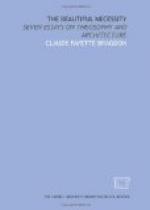Such analyses of the figure, however conducted, reveals an all-pervasive harmony of parts, between which definite numerical relations are traceable, and an apprehension of these should assist the architectural designer to arrive at beauty of proportion by methods of his own, not perhaps in the shape of rigid formulae, but present in the consciousness as a restraining influence, acting and reacting upon the mind with a conscious intention toward rhythm and harmony. By means of such exercises, he will approach nearer to an understanding of that great mystery, the beauty and significance of numbers, of which mystery music, architecture, and the human figure are equally presentments—considered, that is, from the standpoint of the occultist.
V
LATENT GEOMETRY
[Illustration 51: THE HEXAGRAM AND EQUILATERAL TRIANGLE IN NATURE]
It is a well known fact that in the microscopically minute of nature, units everywhere tend to arrange themselves with relation to certain simple geometrical solids, among which are the tetrahedron, the cube, and the sphere. This process gives rise to harmony, which may be defined as the relation between parts and unity, the simplicity latent in the infinitely complex, the potential complexity of that which is simple. Proceeding to things visible and tangible, this indwelling harmony, rhythm, proportion, which has its basis in geometry and number, is seen to exist in crystals, flower forms, leaf groups, and the like, where it is obvious; and in the more highly organized world of the animal kingdom also; though here the geometry is latent rather than patent, eluding though not quite defying analysis, and thus augmenting beauty, which like a woman is alluring in proportion as she eludes (Illustrations 51, 52, 53).
[Illustration 52: PROPORTIONS OF THE HORSE]
[Illustration 53]
By the true artist, in the crystal mirror of whose mind the universal harmony is focused and reflected, this secret of the cause and source of rhythm—that it dwells in a correlation of parts based on an ultimate simplicity—is instinctively apprehended. A knowledge of it formed part of the equipment of the painters who made glorious the golden noon of pictorial art in Italy during the Renaissance. The problem which preoccupied them was, as Symonds says of Leonardo, “to submit the freest play of form to simple figures of geometry in grouping.” Alberti held that the painter should above all things have mastered geometry, and it is known that the study of perspective and kindred subjects was widespread and popular.
[Illustration 54]




